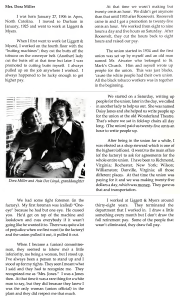Primary Source Set
Tobacco, Part 1: Farmers & Workers
Tobacco was one of North Carolina’s most important industries of the 20th century. One of the reasons that it was so powerful was because it employed so many people and generated significant wealth, especially in the eastern half of the state. This part of the Tobacco lesson uses photographs, videos, and oral histories to illustrate the lives of tobacco farmers, sharecroppers, buyers, and factory workers.
“Whatever you were doing, your job, your existence, your livelihood was connected some way with the tobacco industry, directly or indirectly.”
— James P. Morgan, former American Tobacco Company employee
Time Period
1940s-1980s
Grade Level
8 – 12
Transcript
Dora Miller's story from "Working in Tobacco"
Dora Miller was one of the employees of Liggett & Myers, which was owned by the Duke family’s American Tobacco Company. By her telling, she was one of the first people to help unionize Black employees (white employees had a separate union). Her story comes from a set of recorded histories of several tobacco workers from Durham. The collection was assembled in 1988 at North Carolina Central University.
Contributed to DigitalNC by North Carolina Humanities Council
Durham, N.C. (Durham County)
Background
For decades, tobacco has been one of the most important products in North Carolina’s economy and culture. This was especially true in the century between 1880 and 1980, when several major tobacco companies formed the base of North Carolina’s economy. Tobacco generated so much money in the state that it touched the lives of every North Carolinian, either directly or indirectly, through their jobs, their schools, and the cities they lived in.
Tobacco is a plant that is used to make cigarettes, cigars, dip, and other products (usually for smoking). Nicotine is a chemical in tobacco leaves that can make a tobacco user feel relaxed, but it is also highly addictive. Tobacco products often lead to several grave health consequences, including cancer, heart disease, strokes, and lung disease, plus increased risk for several other illnesses. Even though smoking was known to be dangerous in the 1950s, tobacco companies used marketing and advertising to distort public perception and continue their business for decades longer. It was especially difficult for North Carolinians to condemn the tobacco industry, even in the 1980s and ‘90s, because of the tremendous influence it had in the state. Since then, the decline of the tobacco industry has led to population and job decreases, particularly in the eastern part of the state. This major shift in North Carolina’s economy led to some of the prominent agricultural industries of today, including hog, chicken, and soybean farming.
This influence of tobacco extended to the culture of North Carolina as well. Generations of farmers developed traditions around the planting, harvesting, drying, and auctioning of tobacco plants. Tobacco companies brought new technology into their factories, and workers in those factories advanced civil rights and labor protections. Cigarette advertisements shaped the marketing industry, even appearing in high school and college newspapers. Money from tobacco was used to build up rural communities, cities, and schools. Some of the biggest names in tobacco are still recognizable today, including the Duke family in Durham (owners of the American Tobacco Company), William T. Blackwell and Julian S. Carr (two partners of Bull Durham tobacco), and Richard J. Reynolds of Winston-Salem (proprietor of R. J. Reynolds Tobacco Company).
Discussion Questions
Think about the groups of people who worked in the tobacco industry: farmers, factory workers, and company owners. What interests and opinions did they share? In what ways did they differ?
At the end of Carolina Bright, Tommy Clemment talks about the way tobacco farming has changed over his lifetime. What has changed? What traditions have stayed the same? Which parts of the farming process seem the hardest?
Jean Pittman and Dora Miller describe some of the hardships of working on tobacco farms and in factories, particularly for Black workers. What are some of the ways workers have responded to those challenges?
Children appear in several of these photos and accounts, including the baby on the back of the farmer’s tractor, the child drying tobacco leaves, and Jean Pittman’s story. Why do you think children are so visible in these examples? How does this affect your understanding of the statement that everyone was connected to tobacco?
Tobacco brought a lot of wealth, jobs, and development to North Carolina, but it also sold products that were dangerous to people’s health. Do you think the influence of tobacco in the state was overall positive, negative, or some of both? Why?
This primary source set was compiled by Sophie Hollis.
Updated January 2025
